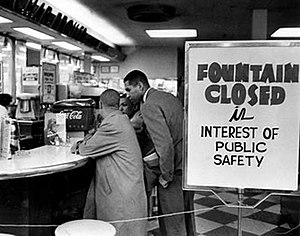| Nashville sit-ins | |||
|---|---|---|---|
| Part of the Sit-in movement in the Civil Rights Movement | |||
 Nashville's sit-in campaign targeted downtown lunch counters such as this one at Walgreens drugstore. | |||
| Date | February 13 – May 10, 1960 (2 months, 3 weeks and 6 days) | ||
| Location | |||
| Caused by |
| ||
| Resulted in |
| ||
| Parties | |||
| |||
| Lead figures | |||
NCLC members Students Lawyers Businessmen
| |||
The Nashville sit-ins, which lasted from February 13 to May 10, 1960, were part of a protest to end racial segregation at lunch counters in downtown Nashville, Tennessee. The sit-in campaign, coordinated by the Nashville Student Movement and the Nashville Christian Leadership Council, was notable for its early success and its emphasis on disciplined nonviolence. It was part of a broader sit-in movement that spread across the southern United States in the wake of the Greensboro sit-ins in North Carolina.[1]
Over the course of the Nashville sit-in campaign, sit-ins were staged at numerous stores in the central business district. Over 150 students were eventually arrested for refusing to vacate store lunch counters when ordered to do so by police. At trial, the students were represented by a group of 13 lawyers, headed by Z. Alexander Looby. On April 19, Looby's home was bombed, although he escaped uninjured.[1] Later that day, at least 3,000 people marched to City Hall to confront Mayor Ben West about the escalating violence.[2] When asked if he believed the lunch counters in Nashville should be desegregated, West agreed that they should.[3][1] After subsequent negotiations between the store owners and protest leaders, an agreement was reached during the first week of May. On May 10, six downtown stores began serving black customers at their lunch counters for the first time.[1]
Although the initial campaign successfully desegregated downtown lunch counters, sit-ins, pickets, and protests against other segregated facilities continued in Nashville until passage of the Civil Rights Act of 1964, which ended overt, legally sanctioned segregation nationwide. Many of the organizers of the Nashville sit-ins went on to become important leaders in the Civil Rights Movement.
© MMXXIII Rich X Search. We shall prevail. All rights reserved. Rich X Search
